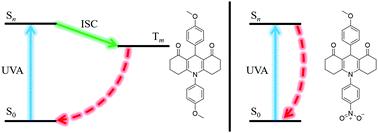Jack M. Woolley, Raúl Losantos, Diego Sampedro and Vasilios G. Stavros
Phys. Chem. Chem. Phys., 2020,22, 25390-25395
DOI:
10.1039/D0CP04940A,
Paper
Many current ultraviolet filters present potential hazards both to humans and to the natural environment. As such there is a new impetus to develop, through intimate characterisation, ultraviolet filters for use in cosmeceuticals. Here we report a new class of organic molecules which have a strong absorption band across the ultraviolet-A and -B regions of the electromagnetic spectrum and high photostability. We have performed ultrafast transient electronic absorption spectroscopy and steady-state spectroscopies, alongside computational studies to track and manipulate photoprotection mechanisms. Our results present a potentially new generation of ultraviolet filters for use in commercial formulations.
